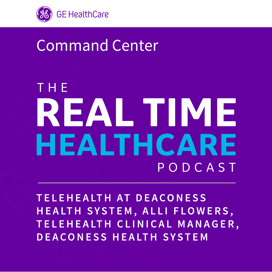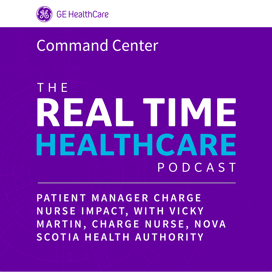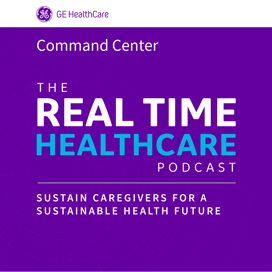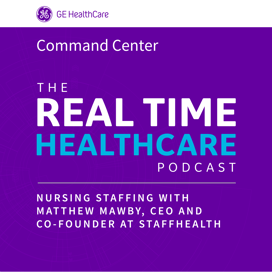In this Episode:
Get an insider perspective about how Duke University Health System uses their Care Hub Command Center to manage capacities and expedite patient flow across their entire enterprise. Miranda Harris, Nurse Manager of Patient Flow shares how GE tiles support collaborative operational decisions that help the team expedite treatments and eliminate bottlenecks.
Jeff Terry:
Hello and welcome. I'm Jeff Terry, delighted to be joined today by Miranda Harris. Who's the nurse manager of patient flow at Duke University Health System. A key leader in their Care Hub, which we're going to talk a lot about. Hi Miranda.
Miranda Harris:
Hello, how are you?
Jeff Terry:
Wonderful. Thank you so much for being here. So I think this episode will be of particular interest to our audience because so many in our audience are peers and colleagues of yours Miranda, right? They're in the day-to-day patient care fight. So I'm just delighted for this, and I'm delighted as working for you and your colleagues is what we do. So I'm just delighted to hear your perspective. So to start, Patient Flow, Duke University Health System Complex, super busy place and hospital network. Could you describe the dynamics of Patient Flow at Duke for us, a day in the life?
Miranda Harris:
Day in the life? So a day in the life for me starts at about 5:00 AM, and it starts with me pulling up my mobile device and pulling up the wall of analytics and looking at my ICAP snap tile before or Capacity snapshot tile, before I get up. I always tell people, that sets the tone and the stage for whether it will be one cup of coffee or two cup of coffee drive in for work. So I start there because it certainly gives me an indication of what to start to expect as I come into the organization. When I come in the first thing in the morning, certainly capacity is a huge issue because we're starting and we're ramping up for the day and we're preparing for a huddle for our teams. So there is a morning huddle with the Care Hub team, which is our charge nurse.
Miranda Harris:
It includes our transfer center nurses, the nurses that will be doing patient placement as well as the REVS dispatchers, and there is our clinical transport or our patient transport dispatchers there. So we certainly are able to discuss what we have, we know where we're starting from, we are able to look at what our pinch points are and we're able to come up with any of the additional issues that may arise throughout the day, and those huddles, I think are really important. They're not long, but they also allow us to identify problems and get the issues to the people who can certainly make the decisions. So if they're, it needs to be something made at that level, we can do it then, if not I escalate it to our second huddle, which is more of our leadership, which also encompasses other individuals that are instrumental for our flow.
And that will include additional people around whether it is our PMROs for our discharge planning, life flight, or any other for information that we need to have in order to continue and start to moving our days events. If nothing is there or something can be resolved there or needs to be resolved higher, we go to a higher leadership, and so they can resolve those issues of certainly be aware. There are other important things. I think that happened throughout that day, there are touchpoints and there are touchpoints with probably some of our key areas. One of them would be pediatrics, another would be labor and delivery of women's health. It is very important for us to understand the capacity management and the Paeds environment, as well as it is for the labor and delivery environment on women's health. So we certainly can have conversations as to whether we need to do some unique things, or if things are going to be status quo for that day.
Additionally, I think there are other huddles that come about and they center around our Periop areas and making that the flow is moving accordingly, and I have to bring up COVID, unfortunately we are in COVID. So a lot of things have to be adjusted or looked at based on the volume of COVID patients in the organization or potentially coming into the organization during that day. So that's pretty much the framework or the palette that we started to work with for each day.
Jeff Terry:
Other than that, it's pretty relaxed, right?
Miranda Harris:
Not bad at all.
Jeff Terry:
One thing, was probably been a month since I was last there, but just you stand in the back of the room and you watch your workspace. There's a lot, you've got a teams meeting on, there's a phone call coming in, someone's coming over asking you something like you're clearly actively problem solving virtually every minute. Can you give an example, what are some of those problems that you're solving in the middle of the day?
Miranda Harris:
So the first thing I would like to start by saying is when you hear an issue that comes forth, it is trying to validate and to ensure that what people feel is exactly what is occurring.
Jeff Terry:
Mm-hmm (affirmative)
Miranda Harris:
So some of the problems that we may be having during the day someone's perception of how fast things are moving, or occurring, or discharges are some of those issues. An area may make the assumption that they're not getting beds, and I'll just use an example of the emergency department. They may, they feel that there is quite a few admissions in there and the rate on which they're receiving their beds may be delayed, and so one of those things is first to validate that, they may have a tremendous number of them, but is it because there are no discharges of available beds at this time? And if there are not, then it quickly lets me know where to drill down.
So now I need to drill down to possibly my PRMO group and look and see, are we going to have more discharges? What is the delay in discharges at this particular time? And then do we need to drill down into any particular units, where are we trying to get patients into? What is the area? So that's some of that work that I'm doing in that back ground, and certainly trying to help problem solve some of those same issues with the staff, if they are run into an issue or something that needs additional research. That's what my role in the bag is doing there.
Jeff Terry:
It's impressive to watch by the way, I just love it. There's clearly a lot happening, with a lot of teams coming together. And when we were chatting earlier, I used the term, I'm an army guy. So it looks like you're fighting the ship, right? You're actively running a battle, but I think you use a dead different analogy.
Miranda Harris:
Yes, I'm a football fan. S I am the coach, and so I recognize, and I always say the football team, everybody's a football player. So they all can catch a ball and they can all run, but you have the quarterback has a specific role, you have your your linemen have a specific and your running backs have a specific role. So certainly that's what I have in the Care hub and in that area. Everyone has their specific role, but they're all nurses, and so they are thinking critically with the same goal of trying to get the right patient, to the right location at the right time. So we're all trying to do that, and if we are find there is a few hiccups on the way, can we quickly problem solve it by looking at the tiles on our own ourselves? Or do we need to have someone to kind of expedite this or investigate a little bit further to get more work done in a more timely manner?
Jeff Terry:
Brilliant. One other question. So I think when you were 17, you probably didn't say I want to be the nurse manager of an Academic Patient Flow and Academic Medical Center. So how did you go from ICU nurse to, how does your career evolve to this role?
Miranda Harris:
Yes, That's interesting, and you are correct. I didn't even know about the Care Hub role at that time. So I did start as an ICU nurse and moved into Patient Flow, as I certainly had an interest in flow over the years through my role as a nurse manager in the ICU, in the organization was one of the things that we pride ourself in. That we do bring people into the organization and try to help with some unique medical conditions, and I took this role and didn't realize what it would expand, but have loved it. So I would say what has prepared me and has been able to get me to this level has been a couple of things, certainly the skillset and the knowledge base of clinical issues. I think secondly, I've used a little bit more informatics than what I would have thought, and had the opportunity to work with other teams that has certainly made a huge difference.
And then I think some of it has been me. I think I had to learn that you have to keep an open mind, things move very fast. We certainly have to improve on how we do things in an organization and how we bring our patients in and how we can capitalize on different skills and resources in order to be able to provide the patients with the treatments that we want to have. So I kind of evolved into that and started to work with, with a lot of different processes and departments just learning and kind of integrating it together.
Jeff Terry:
Heck yes, and you mentioned the informatics side of that and the value that that has at the leadership level, the role that you're in, and obviously I know that we're proud that the GE Tiles are part of that. Could you say a bit more about the Tiles that you use and how you use them?
Miranda Harris:
Yes, sure. So I would say probably the one I use the most is the capacity snapshot, because I am concerned about flow. I'm trying to get patients in, I'm trying not to bottleneck the organization at any given moment and so want to make sure that is smooth. I use it to validate and to watch the flow and to see if I see things coming is it's very good at predicting things. In addition to that, I'm able to start to drill down and even reach out to the right people at the right time. I'm also able to answer the questions for other individuals as they are calling into the care hub, trying to understand. So I do use it to help teach as well. So this is what I see, is this what is occurring?
And let me show you how we can probably figure this out. So I do use it so that it is accurate information that is true data, not my feelings or perception. I also use it to try to improve on how we work in the organization. So I will admit, I will sit with the staff sometimes and watch them make decisions, and I'll just sit there and really keep my mouth shut. Not say anything, but then I watch the tiles to see how that is. You have to come back and validate.
Miranda Harris:
So that's how I use them a lot. I have to even use them to calm me down sometimes during the day, sometimes you think things are not moving as fast as they should, and they really are.
Jeff Terry:
Mm-hmm (affirmative)
Miranda Harris:
It keeps you up and it keeps you updated throughout the day. Again, I use it consistently on my mobile device. So throughout the day and throughout my meetings, I can certainly get a snapshot of where the organization is at any moment in time, when it looks at Capacity and know where I need to start to intervene and start to drill throughout the day.
Jeff Terry:
We'll put a picture of this up, last time I was there. So I love your workstation, you have three monitors in front of you and then you have a large touch screen on your left. Which has I think, Capacity Snapshot and the Infectious Disease Tile, and Patient Manager for discharges. And I understand you've now added a second touch screen, which is kind of just to your right front that has census and staffing forecast, which I think everybody with those tiles should replicate. I mean, it really is like this little, I don't know, like a fighter pilot with this heads up display. Can you talk about that?
Miranda Harris:
Yes, because that does seem excessive in there, but it's not. The tiles up front, so it's important for the team to be able to see the information that they need at a glance. So everyone in the department is working on a specific area. They have their special teams, and so I need for the individuals that are in patient placement to have some clear understanding of where their confirmed discharges are coming from, and from which departments. So they are looking at that particular one. They also have on one side the Capacity Snapshot Tiles, so they're looking at that one. I think probably what I have not mentioned is that I look at all facilities, all three of our hospitals. So our two sister units, hospitals, which is extremely important for the transfer center, because you certainly want to balance and not overstretch one facility versus another facility.
So it is really important to look at that. So they can look at touchpoints on those, and that's probably more important to their work during the day than it is for the patient placement team. There's a charge nurses in there that's trying to help abate some of the things and keep the fires down a little bit, and so that charge nurse has to be able to do that other tile, as you're mentioning that is on my left. That is in there that they can walk up, they can start to scroll down, they can pull up different pictures and different sections of the tile without disturbing the other team players, and so they can customize it to what they need at that moment. And then I have to have my own tile so I am over on the side, and so I'm also able to do that but as we bring up new tiles, I try to validate them.
One that I'm certainly looking at right now is the census forecasting of staffing. So as things are changing or we start to see some capacity issues and we're starting to get concerned about tomorrow and what that's going to look like. I do try to look at that tile, try to take some notes, see what it looks like tomorrow to try to help me predict and how to be able to learn, to use it in order to make it more effective for my department. I'm not hiring or staffing it, but I certainly am. It's important to me to know how that will impact us on the next day.
Jeff Terry:
Absolutely and that's a newer tile. It's an interesting one, yeah. Because it's primary a major use for the staffing office and the charge nurses to update nurse staffing based on what's going to happen in a couple of days, but obviously also useful for managing capacity and really an interesting question because right. You, unlike most people have a sense in your gut of what's going on with Duke Capacity, right? So how that matches and obviously we measure the accuracy, analytically, how it matches your intuition is as important of its of a test. How does it useful?
Miranda Harris:
Yeah, it's very true cause we're humans. So it has to make me feel good, and so when I look at it and have confidence in it, then I'm more willing to work with it and then I think what will happen is we have to learn to trust the material, and the information and the tiles and the data that we're generating to use it. And so I think that's just that human nature to be able to give up a little bit of, I don't know if we would call it control or whatever, but certainly to use all the tools that we have at our disposal in order to be able to make things work more efficient and effectively.
Jeff Terry:
Absolutely and it's an interesting. Makes me think, as you say that, at some point we'll say your intuition strongly makes you believe something and the tile is forecasting something very different.
Miranda Harris:
I have to say, it seems like sometimes I'm out of sync. Usually the tiles have been quite accurate as I have used them and move forward with them.
Jeff Terry:
I'm glad to hear that, awesome. Miranda, thank you so much. As I say, we love working for you and we love shaping all these things with you and watching how you use them and they evolve. So thank you for that and for joining today.
Miranda Harris:
Thank you very much for inviting me. I appreciate it.
Jeff Terry:
Yes ma'am. And with that will close the podcast.







